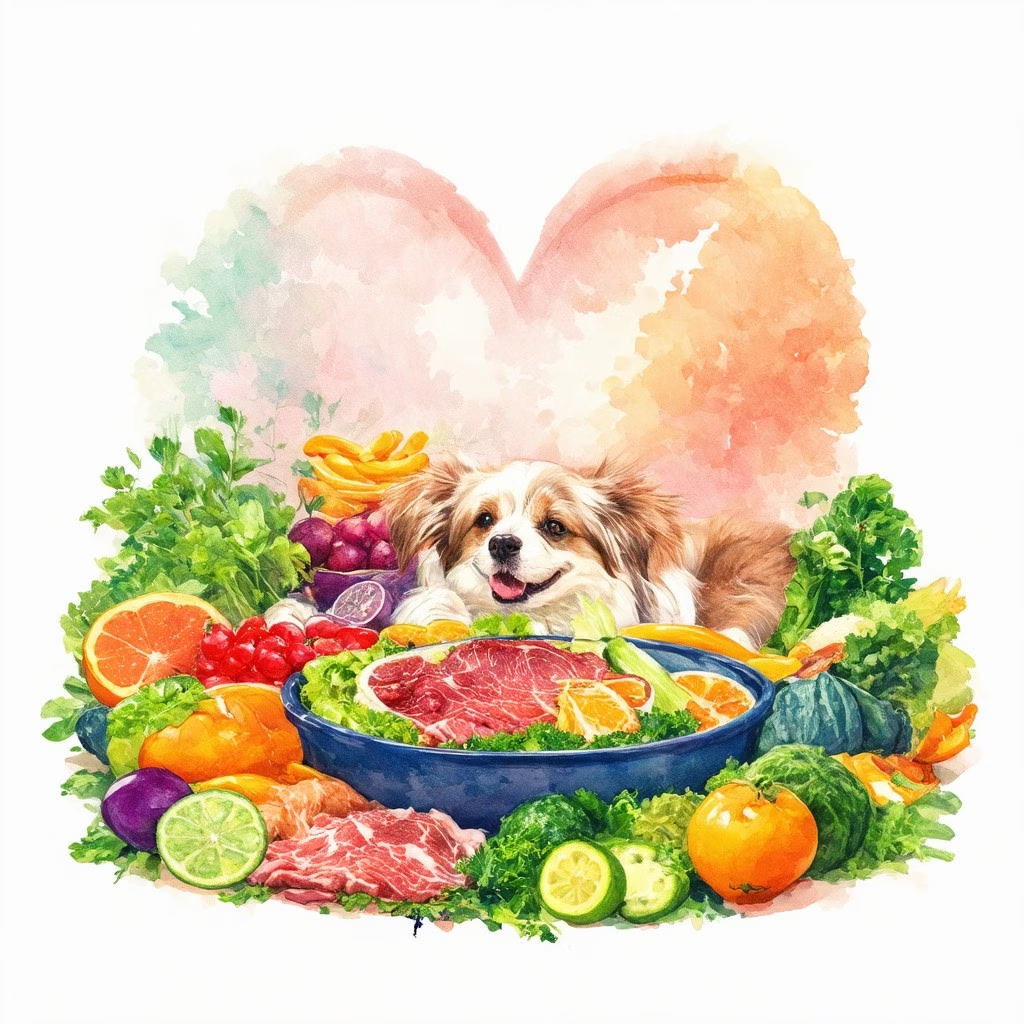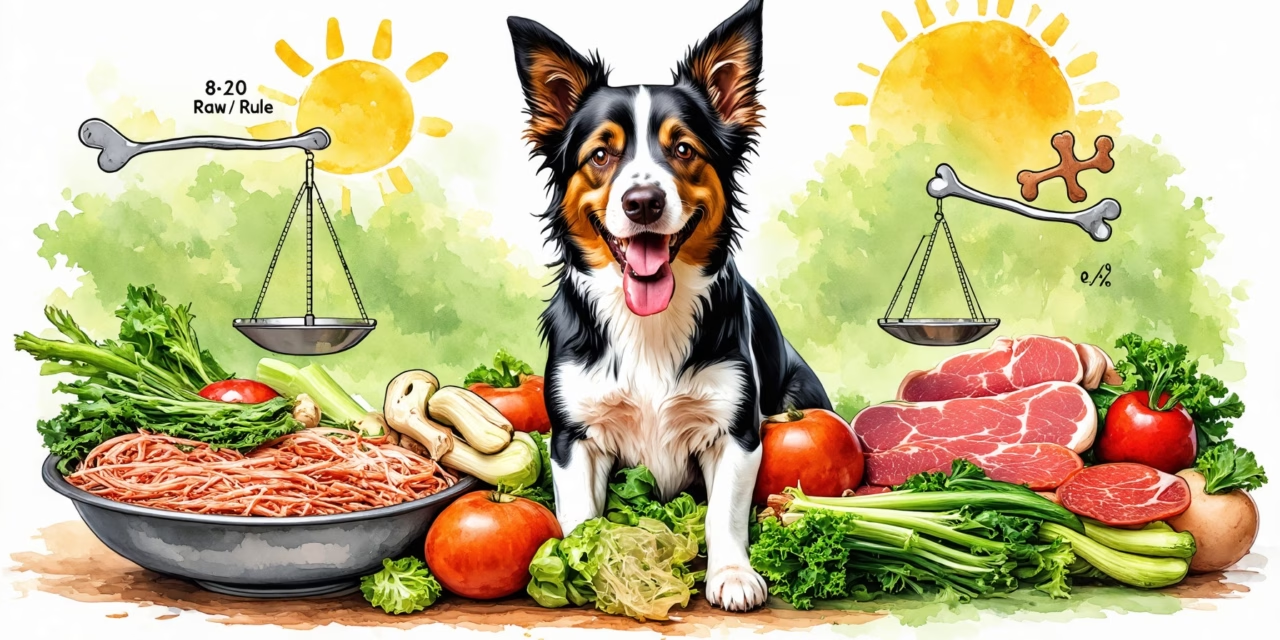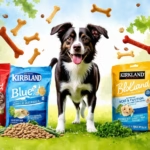Key Takeaways
- Improved Health: A raw diet for dogs can enhance coat and skin health, increase energy levels, and promote better digestion.
- Dental Benefits: Chewing raw bones aids in dental hygiene, reducing plaque buildup and promoting fresher breath.
- Balanced Nutrition: Formulating a raw diet requires careful planning to ensure it meets all essential nutrient needs, preventing nutritional imbalances.
- Food Safety: Proper handling of raw ingredients is crucial to minimize the risk of bacterial contamination, protecting both pets and owners.
- Consult Professionals: Always consult with a veterinarian or pet nutritionist before transitioning to a raw diet to ensure a safe and effective feeding plan.
Welcome to our comprehensive guide on the raw diet for dogs, where we delve into the benefits, challenges, and essential recipes that can lead to a healthier pup. As pet owners increasingly explore the question, is a raw diet better for dogs?, it’s vital to understand both the advantages and potential drawbacks of this feeding approach. In this article, we will explore the numerous benefits of a raw diet for dogs, share delicious and nutritious raw diet recipes for dogs, and address common concerns, such as why some veterinarians may not recommend a raw dog food diet. Additionally, we will guide you on how to start a raw food diet for dogs, including meal plans and the raw dog food calculator to help you tailor the diet to your furry friend’s needs. Join us as we navigate the world of raw feeding, ensuring your dog receives the best nutrition possible.
Is a Raw Diet Better for Dogs?
Raw Diet for Dogs Benefits
A raw diet for dogs, often referred to as a “BARF” (Biologically Appropriate Raw Food) diet, has gained popularity among pet owners who believe it can lead to various health benefits. Here’s a comprehensive look at the pros and cons of a raw dog food diet:
Pros
- Improved Coat and Skin Health: Many dog owners report that their pets have shinier coats and healthier skin after transitioning to a raw diet. This may be attributed to the higher levels of omega-3 and omega-6 fatty acids found in raw meats and fish (Source: Journal of Animal Science).
- Enhanced Dental Health: Chewing on raw bones can help reduce plaque and tartar buildup, promoting better dental hygiene. This natural abrasive action can lead to healthier gums and fresher breath (Source: Veterinary Clinics of North America).
- Increased Energy Levels: Some dogs exhibit increased vitality and energy when fed a raw diet, likely due to the absence of fillers and artificial additives commonly found in commercial dog foods (Source: American Kennel Club).
- Better Digestion: Raw diets are often easier for dogs to digest, leading to smaller, firmer stools. This can be particularly beneficial for dogs with sensitive stomachs (Source: Veterinary Nutrition).
Cons
- Risk of Bacterial Contamination: Raw diets can harbor harmful bacteria such as E. coli, Salmonella, and Listeria, which pose health risks not only to dogs but also to humans handling the food. Proper food handling and hygiene practices are essential (Source: Centers for Disease Control and Prevention).
- Nutritional Imbalance: Formulating a balanced raw diet can be challenging. Without proper knowledge, pet owners may inadvertently create a diet lacking in essential nutrients, leading to deficiencies over time (Source: Association of American Feed Control Officials).
- Cost and Convenience: Raw diets can be more expensive and time-consuming to prepare compared to commercial dog foods. This may not be feasible for all pet owners (Source: Pet Food Industry).
- Potential for Bone Injuries: Feeding whole bones can lead to dental fractures or gastrointestinal blockages if not properly managed. It’s crucial to choose appropriate bone types and sizes (Source: Veterinary Practice).
Raw Diet for Dogs Recipes
When considering a raw diet for dogs, it’s essential to explore various raw diet recipes for dogs that ensure balanced nutrition. Here are some popular options:
- Chicken and Vegetable Mix: Combine ground chicken with finely chopped carrots, spinach, and a small amount of fish oil for added omega fatty acids.
- Beef and Sweet Potato Stew: Slow-cook lean beef with diced sweet potatoes and green beans for a hearty meal.
- Fish and Rice Bowl: Use cooked fish, such as salmon, mixed with brown rice and peas for a nutritious dish.
Always consult with a veterinarian or a pet nutritionist to ensure that the recipes meet your dog’s specific dietary needs.

Is a Raw Diet Better for Dogs?
When considering the question of whether a raw diet is better for dogs, it’s essential to weigh both the benefits and potential drawbacks. While many pet owners advocate for the raw dog food diet due to its perceived health advantages, there are significant factors to consider before making the switch.
Raw Dog Food Diets: Disadvantages and Health Risks
1. Pathogen Exposure: Raw dog food can harbor harmful pathogens, including bacteria such as Salmonella and E. coli, as well as parasites like Toxoplasma and Giardia. These pathogens pose significant health risks not only to dogs but also to humans, especially in households with young children, elderly individuals, or immunocompromised persons (Centers for Disease Control and Prevention, 2021).
2. Nutritional Imbalance: A raw diet may lack essential nutrients if not properly formulated. Dogs require a balanced intake of proteins, fats, vitamins, and minerals. Feeding an unbalanced raw diet can lead to deficiencies or excesses, resulting in health issues such as bone deformities, dental problems, and weakened immune function (American Kennel Club, 2022).
3. Antibiotic Resistance: There is a growing concern that raw diets can contribute to the spread of antibiotic-resistant bacteria. Some bacteria found in raw meat may be resistant to common antibiotics, complicating treatment for infections in both pets and humans (World Health Organization, 2020).
4. Food Safety Risks: Handling raw dog food requires strict hygiene practices to prevent cross-contamination in the kitchen. Improper handling can lead to foodborne illnesses for both pets and their owners (Food Safety and Inspection Service, 2021).
5. Behavioral Issues: Transitioning to a raw diet may lead to behavioral changes in some dogs, such as increased aggression or food guarding, particularly if they are not accustomed to raw feeding (Veterinary Behaviorists, 2023).
In conclusion, while raw dog food diets may offer some benefits, the potential risks associated with pathogens, nutritional imbalances, antibiotic resistance, food safety, and behavioral issues warrant careful consideration. Pet owners should consult with a veterinarian or a pet nutrition expert to ensure a safe and balanced diet for their dogs.
Raw Dog Food Diet for Dogs
When exploring a raw dog food diet, it’s crucial to understand how to implement it safely and effectively. A well-planned raw diet can provide numerous benefits, including improved coat condition, better digestion, and increased energy levels. However, it’s essential to ensure that the diet is balanced and meets all nutritional needs.
To start, consider the following components for a balanced raw diet:
- Meat: Choose high-quality protein sources such as chicken, beef, or lamb. Aim for a variety of meats to provide different nutrients.
- Organs: Include organ meats like liver and kidney, which are rich in vitamins and minerals.
- Bone: Raw meaty bones are essential for calcium and phosphorus. Ensure they are appropriate for your dog’s size to prevent choking hazards.
- Vegetables: Incorporate dog-safe vegetables like carrots, spinach, and broccoli for added fiber and nutrients.
- Supplements: Depending on your dog’s specific needs, consider adding supplements to ensure a complete diet.
For those interested in raw diet recipes for dogs, it’s advisable to consult resources that provide scientifically-backed recipes to ensure nutritional adequacy. Websites like PetMD offer valuable insights into formulating a raw food diet tailored to your dog’s needs.
How to Start a Raw Food Diet for Dogs?
Starting a raw diet for dogs can be a rewarding journey, but it requires careful planning and consideration. Transitioning your dog to a raw dog food diet involves several steps to ensure their health and well-being. Here’s how to effectively introduce a raw diet to your furry friend.
Gradual Introduction
– **Initial Phase**: Begin by mixing 25% raw food with 75% of your dog’s current diet for the first 3 days. This helps your dog’s digestive system adjust to the new food.
– **Intermediate Phase**: Gradually increase the raw food portion to a 50/50 mix for the next 3 days, monitoring your dog’s response.
– **Final Phase**: Continue to increase the raw portion until you reach a 75% raw and 25% old food mix for a few more days before fully transitioning to a raw diet.
– **Alternative Approach**: Introduce raw food as a treat initially, then gradually replace regular meals with raw food over several days.
Monitoring your dog’s response during this transition is crucial. Keep an eye on their stool consistency, energy levels, and any digestive issues. If your dog experiences any digestive problems, consider extending the transition period or consulting with a veterinarian for tailored advice.
Variety and Balancing
Once your dog is fully transitioned to a raw food diet, it’s essential to introduce a diverse range of protein sources. This can include:
– **Protein Variety**: Incorporate chicken, turkey, beef, and fish to ensure a balanced diet.
– **Organ Meats**: Include organ meats like liver and kidney, which are nutrient-dense and beneficial for your dog’s health.
– **Calcium Sources**: Raw meaty bones (RMB) provide a natural source of calcium, but you can also include other calcium sources like dairy or certain vegetables.
Portion control is also vital. Accurately weigh portions to ensure your dog receives the appropriate amount of raw food based on their size, age, and activity level. Maintaining your dog’s usual feeding schedule will provide consistency and stability during the transition.
For more insights on feeding a dog raw food, check out our [raw diet recipes for dogs](https://wellnesscoachingforlife.com/) and [raw food diet for dogs with allergies](https://wellnesscoachingforlife.com/).
What is the 80/20 Rule for Dog Food?
The 80/20 rule for dog food, often referred to as the “biologically appropriate diet,” emphasizes a nutritional balance that consists of 80% high-quality animal protein and 20% other essential ingredients, such as fruits, vegetables, and grains. This dietary approach is rooted in the understanding of a dog’s natural eating habits, which primarily consist of meat, reflecting their carnivorous ancestry.
Importance of Protein
The 80% meat component is crucial for providing dogs with the necessary amino acids, which are vital for muscle development, energy, and overall health. High-quality protein sources include chicken, beef, lamb, and fish. According to the Association of American Feed Control Officials (AAFCO), animal protein should be the primary ingredient in dog food to meet their nutritional needs.
Role of Fruits and Vegetables
The remaining 20% should include a variety of fruits and vegetables, which supply essential vitamins, minerals, and antioxidants. Ingredients like sweet potatoes, blueberries, and spinach can enhance a dog’s immune system and promote healthy digestion. Research published in the Journal of Animal Science highlights the benefits of incorporating plant-based nutrients into canine diets.
Raw Food Diet for Dogs Recipes
Creating a raw food diet for dogs can be both rewarding and beneficial for your pet’s health. Here are some simple and nutritious raw dog food recipes that adhere to the principles of a raw diet:
Basic Raw Meat Recipe
- 1 pound of ground beef or chicken
- 1/2 cup of finely chopped carrots
- 1/2 cup of spinach
- 1/4 cup of blueberries
- 1 tablespoon of fish oil (for omega-3 fatty acids)
Mix all ingredients together and serve fresh. This recipe provides a balanced meal rich in protein and essential nutrients.
Raw Veggie Mix
- 1 pound of ground turkey
- 1/2 cup of sweet potatoes (mashed)
- 1/4 cup of peas
- 1/4 cup of pumpkin puree
- 1 tablespoon of flaxseed oil
This veggie mix is great for adding fiber and vitamins to your dog’s diet. Ensure all ingredients are fresh and suitable for canine consumption.
For more raw diet recipes for dogs, explore our raw diet recipes for dogs section, where you can find a variety of meal ideas tailored to your dog’s needs.

What’s the Best Raw Meat for Dogs?
When considering a raw diet for dogs, selecting the right type of meat is crucial for ensuring your pet’s health and well-being. The best raw meat for dogs typically includes a variety of protein sources that provide essential nutrients. Here are some top choices:
- Chicken: A popular choice due to its availability and affordability. Chicken is rich in protein and can be fed in various forms, including whole carcasses, wings, and thighs.
- Beef: Another excellent protein source, beef can be offered as ground meat or larger cuts. It’s important to choose lean cuts to avoid excessive fat intake.
- Turkey: Similar to chicken, turkey is a lean meat that is often well-tolerated by dogs. It can be a good option for dogs with allergies to other meats.
- Lamb: This is a great alternative for dogs with food sensitivities. Lamb is rich in essential fatty acids and provides a unique flavor that many dogs enjoy.
- Fish: Fish such as salmon and sardines are excellent sources of omega-3 fatty acids, which promote healthy skin and coat. However, ensure that fish is sourced from safe waters to avoid contaminants.
When feeding a dog raw food, it’s essential to balance these meats with appropriate organ meats and bones to create a complete diet. For more detailed raw diet recipes for dogs, you can explore various resources that provide guidance on meal planning.
Raw Food Dog Calculator
To effectively manage a raw dog food diet, utilizing a raw food dog calculator can be beneficial. This tool helps pet owners determine the appropriate portion sizes based on their dog’s weight, age, and activity level. Here are some key features of a raw feeding calculator for dogs:
- Portion Control: It calculates the right amount of raw meat, organs, and bones needed for your dog’s daily intake.
- Nutritional Balance: Ensures that the diet includes a variety of protein sources and essential nutrients to prevent deficiencies.
- Customization: Allows you to input specific dietary needs, such as allergies or health conditions, to tailor the diet accordingly.
Using a raw diet calculator for dogs can simplify the transition to a raw food diet and help maintain your dog’s health. For more information on feeding a dog raw food, check out the resources available at [Wellness Coaching For Life](https://wellnesscoachingforlife.com/).
What’s the Best Raw Meat for Dogs?
When considering the best raw meats for dogs, it’s essential to focus on high-quality, nutrient-dense options that support their overall health. Here’s a comprehensive list of raw meats suitable for canine consumption:
- Chicken: A popular choice, chicken is rich in protein and essential amino acids. Ensure it is free from hormones and antibiotics.
- Beef: Lean cuts of beef, such as ground beef or beef liver, provide iron and zinc, which are vital for a dog’s immune system.
- Lamb: This meat is an excellent source of protein and is often recommended for dogs with food sensitivities.
- Turkey: Lean turkey meat is low in fat and high in protein, making it a healthy option for dogs.
- Fish: Fish like salmon and sardines are packed with omega-3 fatty acids, which promote healthy skin and coat. Always ensure fish is fresh and free from bones.
- Duck: Duck is a rich source of protein and can be beneficial for dogs with allergies to more common meats.
- Venison: This game meat is lean and high in protein, making it suitable for dogs with food allergies.
- Rabbit: Rabbit meat is low in fat and high in protein, making it a great alternative for dogs with sensitivities.
When feeding raw meat to dogs, it’s crucial to ensure that the meat is fresh, high-quality, and free from additives such as sugars, salts, and preservatives. Additionally, always consult with a veterinarian before making significant changes to your dog’s diet, especially when introducing raw foods. For more detailed guidance on canine nutrition, consider resources from reputable organizations like the American Kennel Club or veterinary nutritionists.
Raw Food Dog Calculator
A raw dog food calculator can be an invaluable tool for pet owners transitioning their dogs to a raw diet. This calculator helps determine the appropriate amount of raw food to feed based on your dog’s weight, age, activity level, and health status. By inputting these variables, you can ensure that your dog receives the right balance of nutrients necessary for their well-being. Many pet owners find that using a raw diet for dogs calculator simplifies meal planning and helps maintain optimal health.
Raw Diet Calculator for Dogs
Utilizing a raw diet calculator for dogs can streamline the process of feeding your pet a raw food diet. These calculators typically consider factors such as your dog’s breed, size, and specific dietary needs. For instance, if your dog has health issues like pancreatitis or allergies, the calculator can adjust the recommendations accordingly. This ensures that you are providing a balanced diet tailored to your dog’s unique requirements. For more information on specific dietary needs, visit our section on dog raw food diet.
What is the disadvantage of raw dog food?
While many pet owners advocate for a raw diet for dogs, there are several disadvantages to consider. One significant concern is the risk of bacterial contamination. Raw meat can harbor harmful bacteria such as Salmonella and E. coli, which can pose health risks not only to dogs but also to humans handling the food. Additionally, a raw dog food diet may lead to nutritional imbalances if not properly formulated. It requires careful planning to ensure that all essential nutrients are included, which can be challenging for pet owners without veterinary guidance.
Another disadvantage is the potential for digestive issues. Some dogs may struggle to digest raw food, leading to gastrointestinal upset. Furthermore, transitioning from a traditional kibble diet to a raw diet can cause temporary digestive disturbances, including diarrhea or vomiting. Lastly, the cost of high-quality raw ingredients can be significantly higher than commercial dog food, making it less accessible for some pet owners.
Raw dog food diet for dogs
A raw dog food diet for dogs typically consists of raw meat, bones, fruits, and vegetables. While this diet can provide benefits such as improved coat condition and increased energy levels, it is crucial to be aware of the potential drawbacks. For instance, not all dogs may thrive on a raw diet, particularly those with specific health conditions or dietary restrictions. It’s essential to consult with a veterinarian before making any significant dietary changes.
Moreover, the preparation of raw meals requires time and effort, as pet owners must ensure that the food is safe and balanced. This includes sourcing high-quality ingredients and understanding the appropriate proportions of meat, organ, and bone. For those considering this diet, utilizing a raw feeding calculator for dogs can help in formulating a balanced meal plan tailored to their dog’s needs.
Raw diet for dogs Reddit
Online communities, such as Reddit’s raw feeding subreddit, provide a platform for pet owners to share experiences and advice regarding a raw diet for dogs. These forums can be valuable resources for learning about the practical aspects of feeding a dog raw food, including tips on sourcing ingredients and transitioning dogs to a raw diet. However, it is important to approach information from these sources critically, as not all advice may be scientifically backed or suitable for every dog.
Engaging with these communities can help pet owners gain insights into the challenges and successes of others, but it should not replace professional veterinary advice. Always consider consulting with a veterinarian or a pet nutritionist when exploring a dog raw food diet to ensure the health and well-being of your pet.













